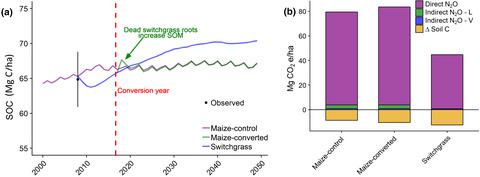当前位置:
X-MOL 学术
›
GCB Bioenergy
›
论文详情
Our official English website, www.x-mol.net, welcomes your
feedback! (Note: you will need to create a separate account there.)
The carbon and nitrogen cycle impacts of reverting perennial bioenergy switchgrass to an annual maize crop rotation
Global Change Biology Bioenergy ( IF 5.9 ) Pub Date : 2020-09-29 , DOI: 10.1111/gcbb.12743 Caitlin E. Moore 1, 2, 3 , Danielle M. Berardi 1, 4 , Elena Blanc‐Betes 1 , Evan C. Dracup 5 , Sada Egenriether 6 , Nuria Gomez‐Casanovas 1, 7 , Melannie D. Hartman 1, 8 , Tara Hudiburg 1, 4 , Ilsa Kantola 2, 9 , Michael D. Masters 2, 7, 9 , William J. Parton 1, 8 , Rachel Van Allen 1, 9 , Adam C. Haden 1, 2 , Wendy H. Yang 1, 2, 6, 7, 9 , Evan H. DeLucia 1, 2, 7, 9 , Carl J. Bernacchi 1, 5, 7, 9
Global Change Biology Bioenergy ( IF 5.9 ) Pub Date : 2020-09-29 , DOI: 10.1111/gcbb.12743 Caitlin E. Moore 1, 2, 3 , Danielle M. Berardi 1, 4 , Elena Blanc‐Betes 1 , Evan C. Dracup 5 , Sada Egenriether 6 , Nuria Gomez‐Casanovas 1, 7 , Melannie D. Hartman 1, 8 , Tara Hudiburg 1, 4 , Ilsa Kantola 2, 9 , Michael D. Masters 2, 7, 9 , William J. Parton 1, 8 , Rachel Van Allen 1, 9 , Adam C. Haden 1, 2 , Wendy H. Yang 1, 2, 6, 7, 9 , Evan H. DeLucia 1, 2, 7, 9 , Carl J. Bernacchi 1, 5, 7, 9
Affiliation

|
In the age of biofuel innovation, bioenergy crop sustainability assessment has determined how candidate systems alter the carbon (C) and nitrogen (N) cycle. These research efforts revealed how perennial crops, such as switchgrass, increase belowground soil organic carbon (SOC) and lose less N than annual crops, like maize. As demand for bioenergy increases, land managers will need to choose whether to invest in food or fuel cropping systems. However, little research has focused on the C and N cycle impacts of reverting purpose‐grown perennial bioenergy crops back to annual cropping systems. We investigated this knowledge gap by measuring C and N pools and fluxes over 2 years following reversion of a mature switchgrass stand to an annual maize rotation. The most striking treatment difference was in ecosystem respiration (ER), with the maize‐converted treatment showing the highest respiration flux of 2,073.63 (± 367.20) g C m−2 year−1 compared to the switchgrass 1,412.70 (± 28.72) g C m−2 year−1 and maize‐control treatments 1,699.16 (± 234.79) g C m−2 year−1. This difference was likely driven by increased heterotrophic respiration of belowground switchgrass necromass in the maize‐converted treatment. Predictions from the DayCent model showed it would take approximately 5 years for SOC dynamics in the converted treatment to return to conditions of the maize‐control treatment. N losses were highest from the maize‐converted treatment when compared to undisturbed switchgrass and maize‐control, particularly during the first conversion year. These results show substantial C and N losses occur within the first 2 years after reversion of switchgrass to maize. Given farmers are likely to rotate between perennial and annual crops in the future to meet market demands, our results indicate that improvements to the land conversion approach are needed to preserve SOC built up by perennial crops to maintain the long‐term ecological sustainability of bioenergy cropping systems.
中文翻译:

将多年生生物能源柳枝to恢复为年度玉米轮作的碳氮循环影响
在生物燃料创新时代,生物能源作物可持续性评估已经确定了候选系统如何改变碳(C)和氮(N)循环。这些研究工作揭示了多年生作物(如柳枝switch)与地下作物(如玉米)相比如何增加地下土壤有机碳(SOC)并减少了更少的氮。随着对生物能源需求的增加,土地管理人员将需要选择是投资于粮食还是燃料种植系统。但是,很少有研究集中在将目的生长的多年生生物能源作物恢复为年度种植系统的碳和氮循环影响上。我们通过测量成熟的柳枝stand林恢复为每年玉米轮作后的2年中的C和N池和通量,研究了这种知识缺口。最明显的处理差异是生态系统呼吸(ER),−2 年− 1年,柳枝1,1,412.70(±28.72)g C m − 2 年-1和玉米对照处理1,699.16(±234.79)g C m − 2 年-1。玉米转化处理中地下柳枝ne坏死菌的异养呼吸增加可能是造成这种差异的原因。DayCent模型的预测表明,转化处理后的SOC动态大约需要5年才能恢复到玉米对照处理的条件。与不受干扰的柳枝and和玉米对照相比,玉米转化处理的氮素损失最高,尤其是在第一年。这些结果表明,柳枝re还原为玉米后的前两年内,大量的碳和氮损失发生。鉴于将来农民可能会在多年生和一年生作物之间轮换以满足市场需求,
更新日期:2020-10-15
中文翻译:

将多年生生物能源柳枝to恢复为年度玉米轮作的碳氮循环影响
在生物燃料创新时代,生物能源作物可持续性评估已经确定了候选系统如何改变碳(C)和氮(N)循环。这些研究工作揭示了多年生作物(如柳枝switch)与地下作物(如玉米)相比如何增加地下土壤有机碳(SOC)并减少了更少的氮。随着对生物能源需求的增加,土地管理人员将需要选择是投资于粮食还是燃料种植系统。但是,很少有研究集中在将目的生长的多年生生物能源作物恢复为年度种植系统的碳和氮循环影响上。我们通过测量成熟的柳枝stand林恢复为每年玉米轮作后的2年中的C和N池和通量,研究了这种知识缺口。最明显的处理差异是生态系统呼吸(ER),−2 年− 1年,柳枝1,1,412.70(±28.72)g C m − 2 年-1和玉米对照处理1,699.16(±234.79)g C m − 2 年-1。玉米转化处理中地下柳枝ne坏死菌的异养呼吸增加可能是造成这种差异的原因。DayCent模型的预测表明,转化处理后的SOC动态大约需要5年才能恢复到玉米对照处理的条件。与不受干扰的柳枝and和玉米对照相比,玉米转化处理的氮素损失最高,尤其是在第一年。这些结果表明,柳枝re还原为玉米后的前两年内,大量的碳和氮损失发生。鉴于将来农民可能会在多年生和一年生作物之间轮换以满足市场需求,











































 京公网安备 11010802027423号
京公网安备 11010802027423号